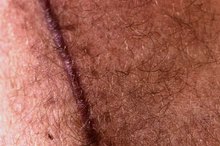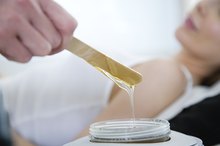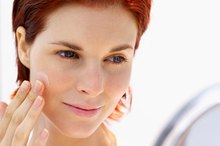What does fact checked mean?
At Healthfully, we strive to deliver objective content that is accurate and up-to-date. Our team periodically reviews articles in order to ensure content quality. The sources cited below consist of evidence from peer-reviewed journals, prominent medical organizations, academic associations, and government data.
The information contained on this site is for informational purposes only, and should not be used as a substitute for the advice of a professional health care provider. Please check with the appropriate physician regarding health questions and concerns. Although we strive to deliver accurate and up-to-date information, no guarantee to that effect is made.
How to Remove a Deep Scar on My Lip
Injury to delicate lips can cause deep, noticeable scars. Scars form when deeper injuries heal, and the longer an injury takes to heal, the greater the risk of scar formation, according to the American Academy of Dermatology. As scars heal, they flatten and fade, but this takes time and with facial scar formations, you'll want results quickly. Treating deep lip scars can be done with a combination of at-home treatments and dermatological assistance.
Apply an over-the-counter retinol cream to your scar. According to CareFair.com, retinols are effective at regenerating your skin to reduce scar visibility. Retinoids are an effective prescription alternative to retinols.
How to Massage Scars to Help Heal Them
Learn More
**Relax with a dermatologist performed professional chemical peel 2. According to the American Academy of Dermatology, your dermatologist will apply natural acids to your face to remove the outer layers of damaged skin. As the skin heals, it is more even. Chemical peels are extremely effective for deeper scars.
Apply over-the-counter alpha hydroxy acids once daily, suggests CareFair.com. Alpha hydroxy acids exfoliate your skin, causing lip and other facial scars to fade, becoming less noticeable with repeated use.
How to Remove Holes Caused by Acne Scars
Learn More
Visit your dermatologist for dermabrasion treatments 2. According to KidsHealth.org, a small wire brush or diamond filing instrument are used to exfoliate your skin, removing damaged top layers. Healing time after dermabrasion can take up to three weeks.
Opt for soft tissue fillers to plump indented deep lip scars. According to the American Academy of Dermatology, natural collagens derived from humans or bovines are used to fill in scars and reduce their appearance. Injections must be repeated often to maintain results.
Related Articles
References
- Cold Sores: Overview. (n.d.).
- Dermatologists share tips for treating cold sores. (2015).
- Kaye KM. (2018). Herpes simplex virus (HSV) infections.
- Mayo Clinic Staff. (2018). Cold sore.
- World Health Organization. (2017). Herpes simplex virus [Fact sheet].
- Fabbrocini, G, Annunziata, MC, D'Arco, V, et al. Acne scars: pathogenesis, classification and treatment. Dermatol Res Pract. 2010;2010:893080. doi:10.1155/2010/893080
- Kravvas G, Al-niaimi F. A systematic review of treatments for acne scarring. Part 1: Non-energy-based techniques. Scars Burn Heal. 2017;3:2059513117695312. doi:10.1177/2059513117695312
- Gozali MV, Zhou B. Effective treatments of atrophic acne scars. J Clin Aesthet Dermatol. 2015;8(5):33-40.
- Wollina U, Goldman A. Fillers for the improvement in acne scars. Clin Cosmet Investig Dermatol. 2015;8:493-9. doi:10.2147/CCID.S86478
- Kravvas G, Al-niaimi F. A systematic review of treatments for acne scarring. Part 2: Energy-based techniques. Scars Burn Heal. 2018;4:2059513118793420. doi:10.1177/2059513118793420
- Ogawa R. Keloid and hypertrophic scars are the result of chronic inflammation in the reticular dermis. Int J Mol Sci. 2017;18(3). doi:10.3390/ijms18030606
- Rabello FB, Souza CD, Farina júnior JA. Update on hypertrophic scar treatment. Clinics (Sao Paulo). 2014;69(8):565-73. doi:10.6061/clinics/2014(08)11
- França K, Keri J. Psychosocial impact of acne and postinflammatory hyperpigmentation. An Bras Dermatol. 2017;92(4):505-509. doi:10.1590/abd1806-4841.20175645
- Tosti, A, De Padova, MP, Beer, KR, eds. Acne Scars: Classification and Treatment. London: Informa UK Ltd.; 2010.
Writer Bio
Sharin Griffin has been a freelance writer since 2009, specializing in health-related articles. She has worked in the health-care industry as a certified nursing assistant and medical technician. Griffin's medical expertise encompasses bariatrics and geriatric care, with an emphasis on general medicine. She is completing an associate degree in health-care administration from Axia University.









